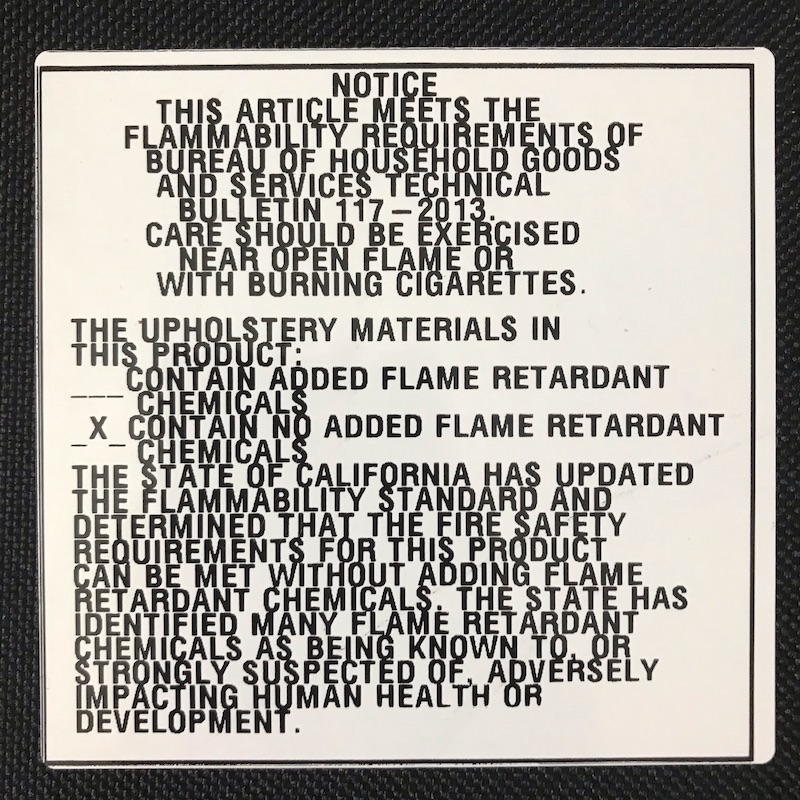We finally bought ourselves a new sofa and, I’m in love.
Just like when we upgraded our bed, I wanted to find a non-toxic sofa… or as close to non-toxic as we could with our budget. This meant, at minimal, getting one without flame retardant chemicals.
A brief history of flame retardants
Flame retardants became widely introduced in the mid 1970’s. It started when manufacturers of children’s clothing began incorporating flame retardants into pajamas. From there, they moved into furniture, mattresses, carpets, curtains, vehicle interiors, and a mass variety of consumer products including strollers, carseats… you name it. The main reason: cigarettes. In the 1970’s, it was so common for people to smoke in their homes. With that came the danger of house fires. Ashes could drop on the floor or furniture, or someone might fall asleep in bed or on the couch with a lit cigarette in hand.
These days, thankfully, fewer people are smoking in their homes. Laws are slowly being changed, and companies are slowly moving away from using flame retardant chemicals in their manufacturing. Still though, they’re way too common.
Dangers of flame retardant chemicals
Flame retardants bioaccumulate. This means they build up over time in our bodies, and in our environment.
Dangers of flame retardants include cancer, endocrine disruption, immune system suppression, reproductive organ harm, adverse effects on fetal and child development, and neurological harm.
Flame retardant particles release from our furniture, landing on our floors, in our dust, on our children’s toys, on our food, and all over our environment.
As furniture gets older, the materials break down and release flame retardants into our homes even easier. The day that I learned this was the day I was ready to drag our old couches out the door and buy a new set. Our couches were nearly 20 years old and had multiple tears in the fabric, making it easier for the chemicals to escape… especially with my daughter jumping on them all the time.
Children are the most susceptible to harm done by flame retardants, as their brains and organs are still developing. Studies have found that children have some of the highest concentrations of flame retardants in their bodies. It makes sense because babies are so close to the floor and so often put their hands toys in their mouths.
Shopping for a couch without flame retardants
Before shopping for new furniture, know where to go and what to look for. We wasted some time not knowing where to turn to first.
The first day we went shopping for a new sofa, we hit a local big-box store. A salesman welcomed us at the door with the question, “What brings you in today?” My husband let him know we were shopping around for a new couch and I perked up to ask if they had any without flame retardants. He responded, “All of our furniture has flame retardants, I’m sure you’ll find something you like.” I said, “Oh, ok well I’m looking for one without flame retardants.” The guy looked at me like I had four heads. He asked why I wouldn’t want a couch with flame retardants. I said something along the lines of, well because they’re terribly bad for your health, especially for kids, and I’m not worried about our couch catching fire. He told me flame retardants are an industry requirement (wrong!). I told him that was lifted in 2015 and more and more companies are not using them. It certainly didn’t seem like the topic had ever been brought up with the man before.
After leaving that store, we hit up another. Same thing. According to the salesman, all of their couches had flame retardants and I’d be hard pressed to find one anywhere without them.
After looking in the right places, I realized there are lots of companies offering furniture without the use of flame retardants.
Some of the furniture companies I’m aware of that don’t use flame retardants:
Medley
Ethan Allen
Mitchell Gold + Bob Williams
Crate and Barrel
Room & Board
William Sonoma (Pottery Barn, West Elm)
Ashley Furniture
Ikea
There are plenty of other companies that I’m sure can be added to this list… these are just the ones that I became aware of when shopping for our new couch.
The most important thing to know is what to look for. When shopping for a new sofa, make sure to lift the cushions and check the label. This is what you want to see: a selection (X) next to the statement “CONTAIN NO ADDED FLAME RETARDANT CHEMICALS”


It’s important to note that just because the furniture doesn’t have flame retardants, it doesn’t mean it’s completely non-toxic. It certainly cuts down on some of the worst stuff, but if you’re looking to get truly non-toxic furniture, the rest of the material should be considered too. The Environmental Working Group suggests avoiding not only flame retardants, but stain-guard and water-repellant surfaces as well. These materials often use perfluorinated chemicals, or PFCS which have a link to cancer, reproductive harm, birth defects, developmental delays, and a suppression of the immune system.
Also, take into consideration the materials used to construct the furniture. Plywood, particle board, and composite wood frames often use glues that emit formaldehyde. Sustainably sourced solid wood is the way to go, if and when possible.
Sources
https://www.niehs.nih.gov/health/topics/agents/flame_retardants/index.cfm
https://www.p65warnings.ca.gov/fact-sheets/flame-retardants
https://www.ewg.org/healthyhomeguide/upholstered-furniture/
https://pubmed.ncbi.nlm.nih.gov/24313667/
https://greensciencepolicy.org/wp-content/uploads/2017/03/Buying_FR-free_furniture.pdf



